This squid ink tagliolini recipe is a classic dish from the Italian coast, known for its rich flavor and its striking deep-black color.
In Italy it's called Tagliolini al Nero di Seppia, and it's traditionally prepared with fresh cuttlefish, although squid makes an excellent substitute and is easier to find. Both give this Italian squid ink pasta its delicate texture and distinctive briny taste.
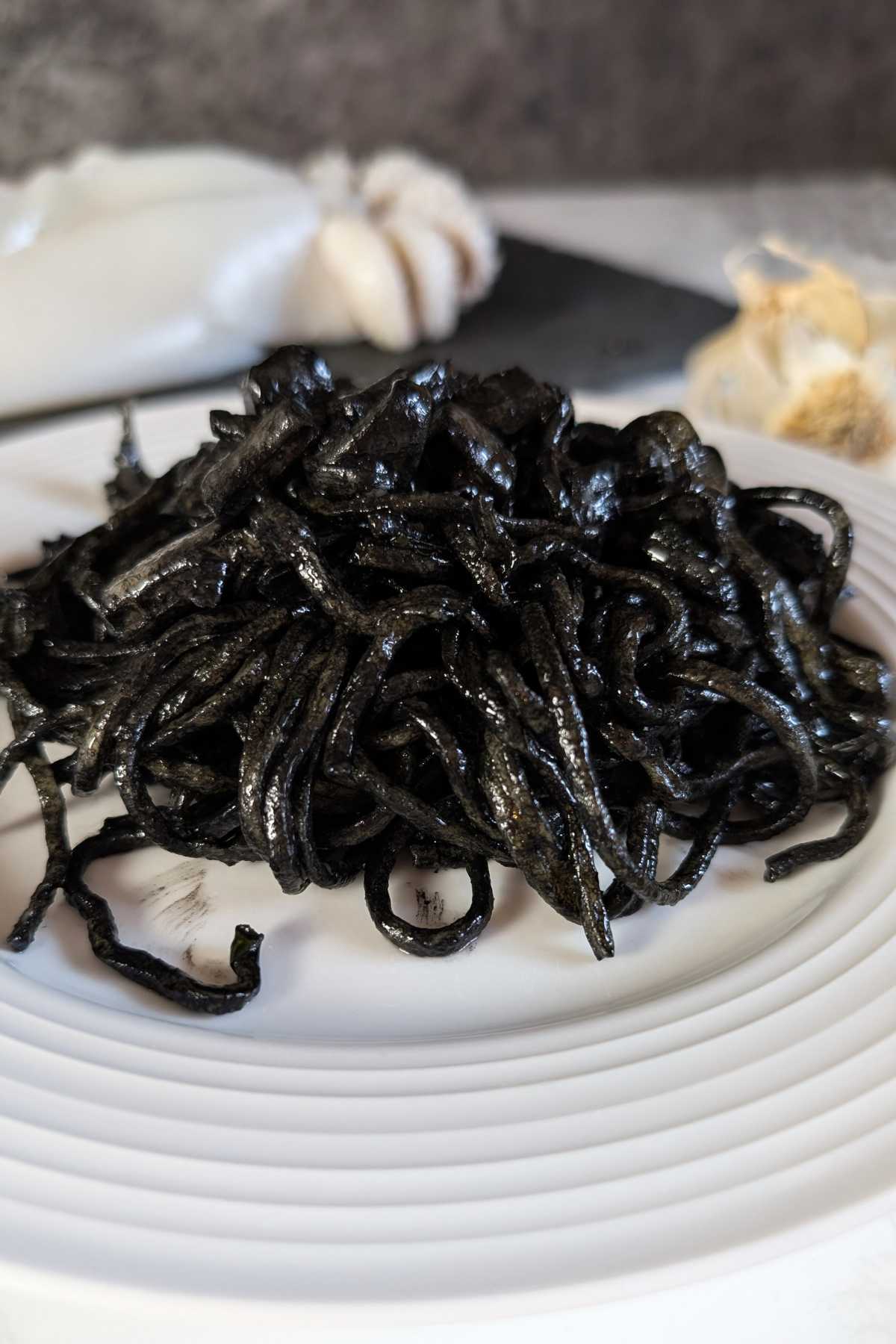
For this version, I decided to make homemade tagliolini, because the combination of “00” flour and semolina flour creates a thin, silky pasta that holds the sauce beautifully. But you don’t need to make fresh pasta to enjoy this dish. If you prefer a quicker option, you can easily use linguine or spaghetti, which work very well with squid-ink sauces and still give you a wonderfully balanced result.
The sauce is simple and comes together in just a few minutes. Tender pieces of cuttlefish or squid are gently sautéed with garlic and extra virgin olive oil, then simmered with dry white wine and squid ink, which transforms everything into a smooth, glossy black sauce. The final dish tastes elegant yet comforting, with that unmistakable flavor that makes squid-ink pasta so unique.
You can use fresh tagliolini or your favorite long pasta shape. Either way, this authentic squid ink pasta brings a true taste of the Italian seaside to your kitchen.
Ingredients

Prep Time: 1 Hour | Cook Time: 15 Min | Servings: 4
FOR HOMEMADE TAGLIOLINI
- 150 g (1 cup) “00” flour
- 150 g (1 cup) semolina flour
- 3 medium eggs (about 65-70 g / 2.3-2.5 oz each)
FOR THE SQUID INK SAUCE
- 700 g (1.5 lb) cleaned cuttlefish or squid
- 8 g (1 teaspoon) nero di seppia (cuttlefish ink or squid ink)
- 1 garlic clove
- 40 g (3 tablespoons) extra virgin olive oil
- 80 g (⅓ cup) dry white wine
- Salt, to taste
- Black pepper, to taste
- Chopped fresh parsley, to taste
Instructions
Make the Tagliolini
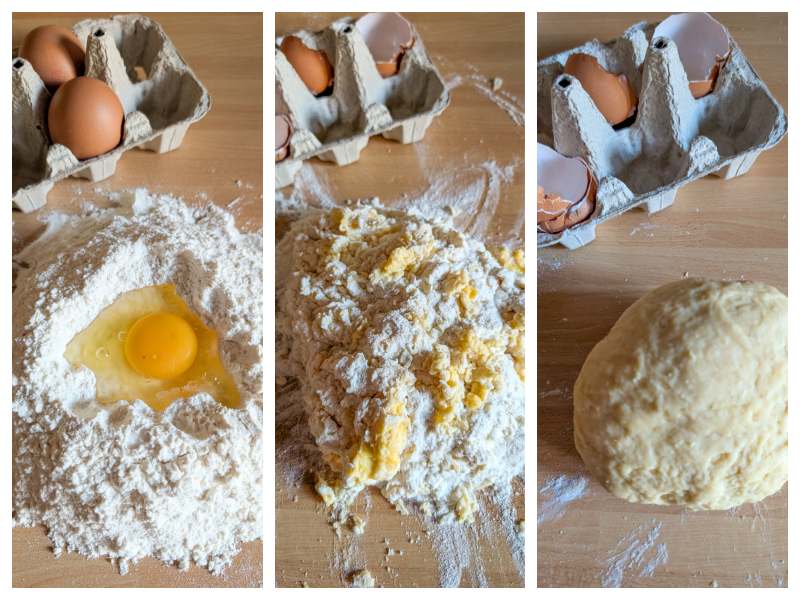
Step 1) - To make fresh tagliolini at home, place both flours on a clean work surface and form a mound. Create a well in the center and add the eggs. Beat them with a fork, gradually incorporating the flour until a dough starts to form.
Knead by hand for about 10 minutes, until the dough is smooth and elastic. Shape it into a ball, wrap it in plastic wrap and let it rest in the fridge for about 30 minutes.
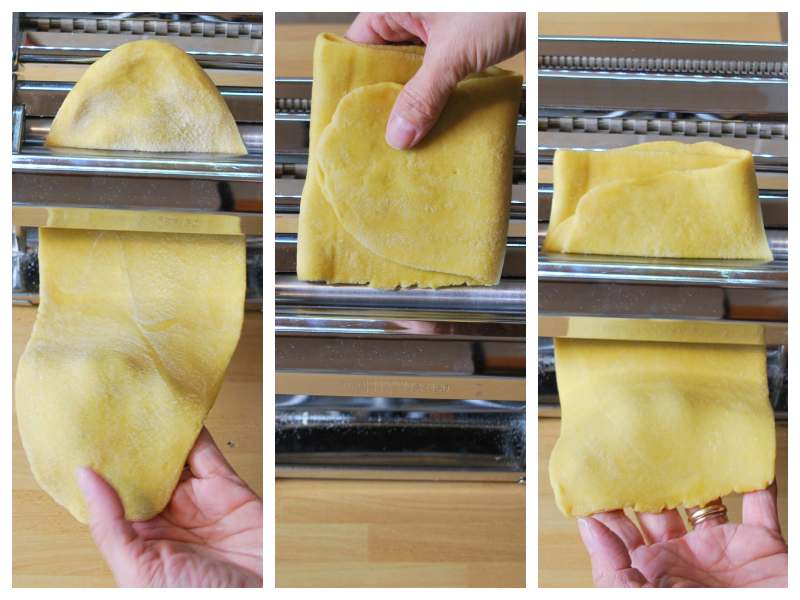
Step 2) - Once rested, flatten the dough slightly and dust it with a little semolina. Pass it through the pasta machine on the widest setting.
Fold the sheet in half or in thirds and roll it through again. Repeat this roll-and-fold process 3 to 4 times to strengthen the dough and achieve a silky texture.
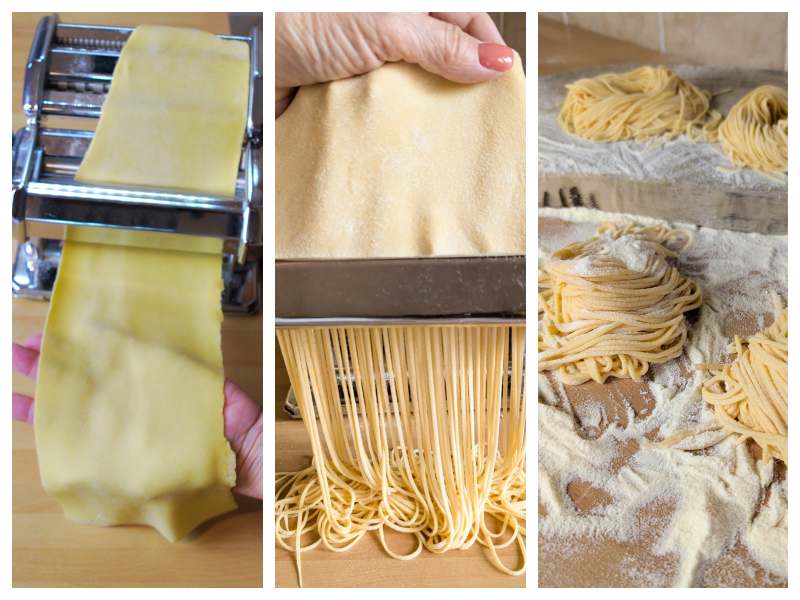
Step 3) - Reduce the thickness one notch at a time, rolling the dough until you reach the second-to-last setting, which gives the ideal thinness for tagliolini (about 1 millimeter).
You should now have smooth, even sheets. Cut them using the tagliolini attachment. Let the pasta dry briefly on a rack or arrange it into loose nests on a semolina-dusted tray.
For more information read How to Make Italian Homemade Pasta
Make the Squid Ink Tagliolini
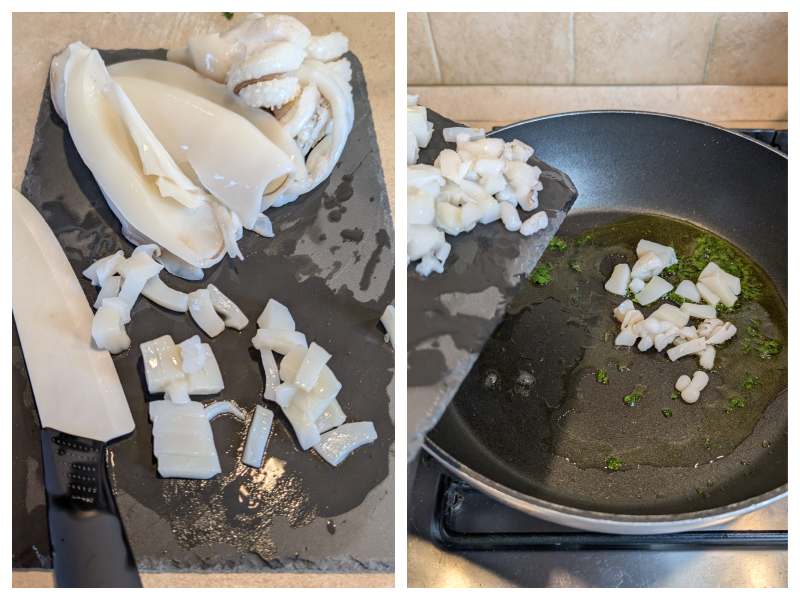
Step 4) - Cut the cuttlefish - or the cleaned squid - into small, even pieces so they cook quickly and stay tender. Heat the extra virgin olive oil in a large frying pan and add the peeled garlic clove along with a spoonful of chopped parsley. Let the garlic gently sizzle until it turns lightly golden and fragrant. Add the cuttlefish or squid, stir well and sauté over medium heat for about 5 minutes.
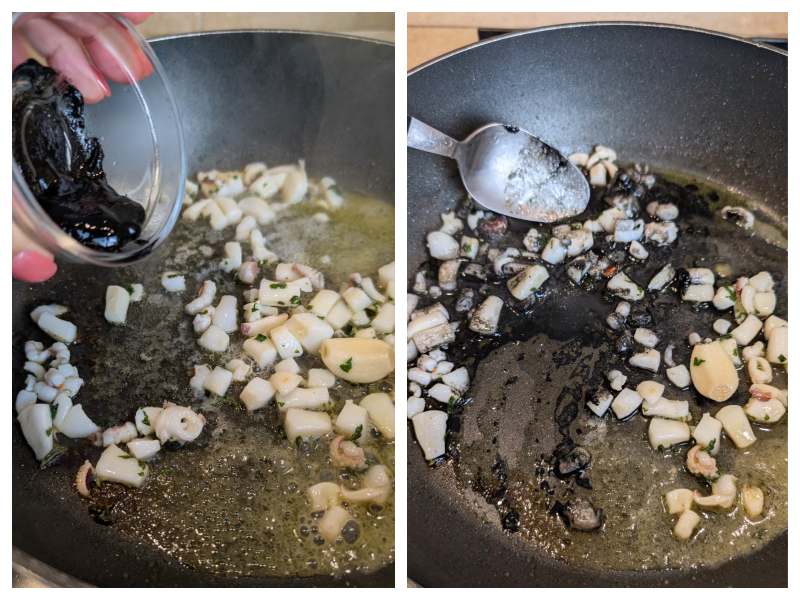
Step 5) - Pour in the dry white wine and let it evaporate completely. Season with a small pinch of fine salt, then add the squid ink. Stir until the ink dissolves and coats the seafood, creating a glossy, deep-black sauce. Lower the heat and let everything simmer for a couple of minutes so the flavors come together. Remove the garlic, turn off the heat and set aside.
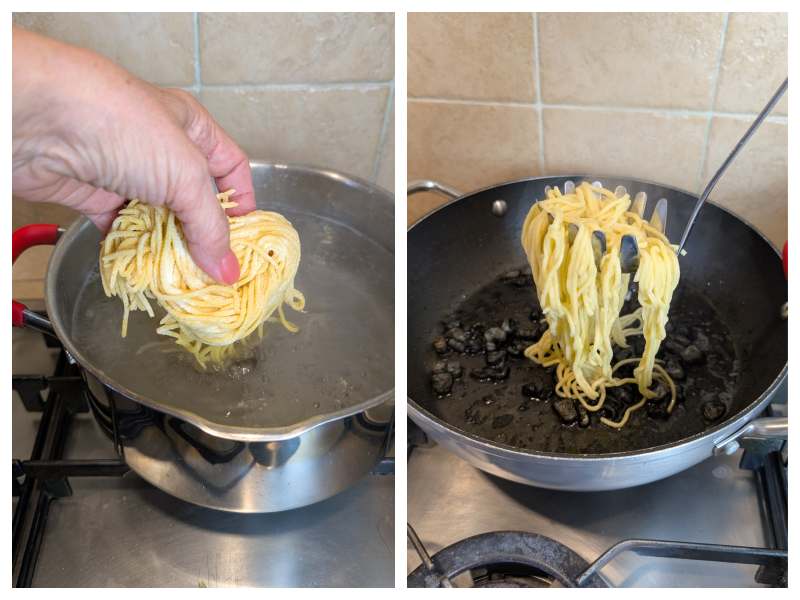
Step 6) - Bring a large pot of salted water to a boil. Cook the fresh tagliolini for 3 to 5 minutes, until just al dente. Using tongs or a pasta fork, transfer the pasta directly into the pan with the sauce. A little pasta water is welcome: it helps the sauce cling to the tagliolini.

Step 7) - Toss gently until the pasta is fully coated and the sauce has a smooth, velvety consistency. Finish with more freshly chopped parsley and a touch of black pepper. Serve your Tagliolini al Nero di Seppia immediately, while the sauce is still glossy and aromatic.
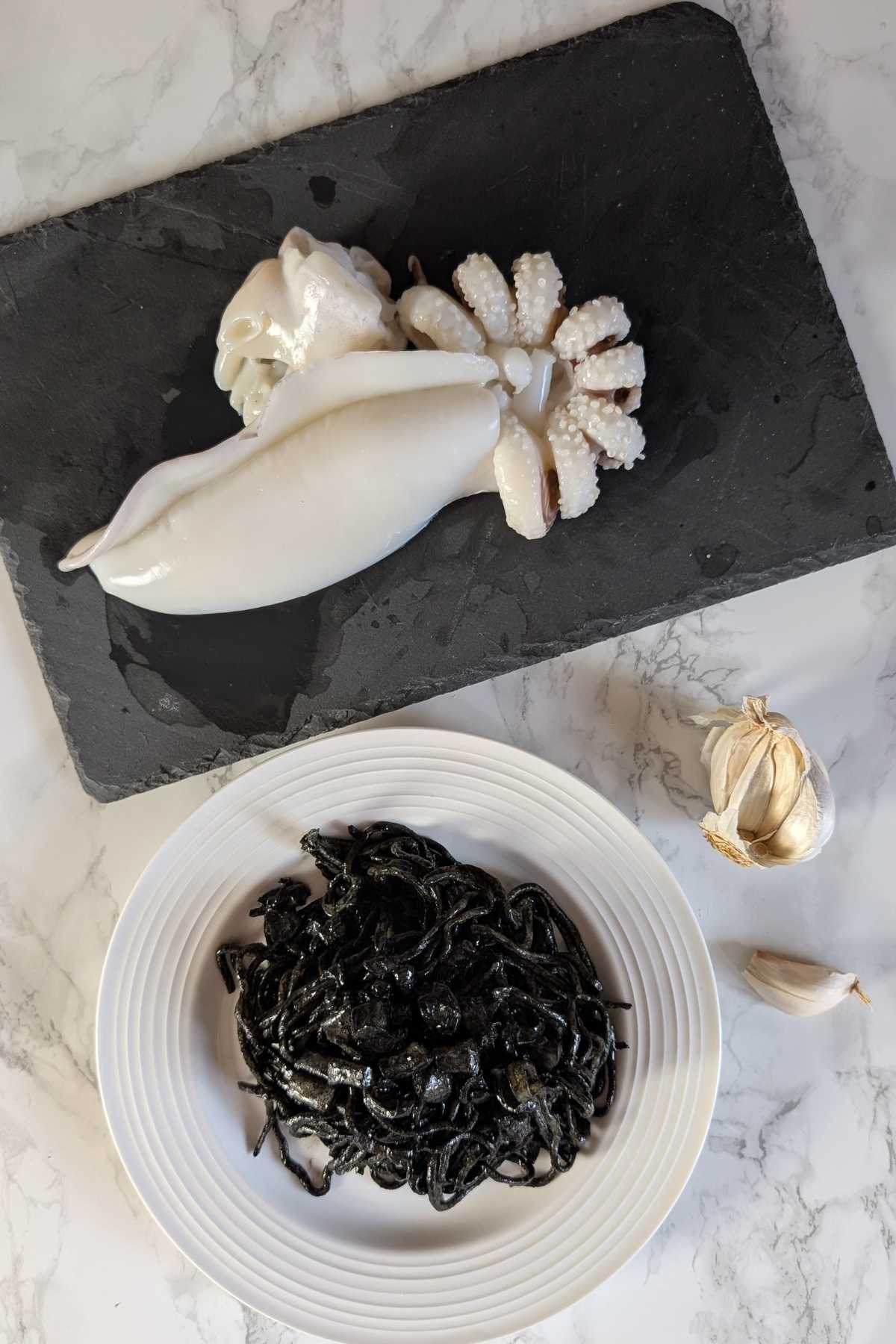
Storage
Squid Ink Tagliolini is best enjoyed immediately, while the sauce is silky and the seafood remains tender. If you have leftovers, let them cool completely, then transfer them to an airtight container and refrigerate for up to 1 day.
Keep in mind that cuttlefish and squid tend to firm up when reheated, so the texture will not be as delicate as when freshly cooked. Reheat the pasta gently in a skillet with a splash of water or a drizzle of olive oil, just until warmed through.
If you prepared the fresh tagliolini in advance, you can store the uncooked pasta in the refrigerator for 1 to 2 days, or freeze it. To freeze, arrange the nests on a tray until firm, then transfer them to a freezer-safe bag. Cook the pasta directly from frozen, adding an extra minute of cooking time.
Tips
- Cuttlefish or squid both work well. Cuttlefish has a slightly softer texture, but squid is easier to find and gives an equally delicious result.
- Use high-quality squid ink. It should be glossy and jet-black, with a clean briny smell. If you buy it in small sachets, use the whole packet once opened.
- Don’t overcook the seafood. Both cuttlefish and squid can turn tough if cooked too long. Keep the heat moderate and sauté just until opaque before adding the wine.
- Let the wine evaporate fully. This step removes acidity and leaves only the aroma, helping the sauce taste smooth and well-balanced.
- Fresh pasta cooks quickly. Homemade tagliolini need only 3 to 5 minutes, depending on thickness. Taste frequently and stop at al dente.
- Transfer the pasta directly to the pan. A bit of cooking water helps emulsify the squid-ink sauce, making it cling beautifully to the tagliolini.
- Choose the right pasta. Fresh homemade tagliolini give the dish a silky texture and absorb the sauce beautifully, but linguine or spaghetti are excellent alternatives. Long, thin shapes work best because they coat evenly with squid-ink sauce.

FAQs
“Al nero di seppia” is an Italian expression meaning “with cuttlefish ink.” It refers to dishes cooked with squid or cuttlefish ink, which gives the sauce its deep black color and its distinctive briny, slightly sweet flavor. In this recipe, the ink is used to create a rich, glossy sauce that coats the pasta beautifully.
Yes. Squid ink is completely safe and commonly used in Mediterranean and Japanese cooking. It has a mild, savory flavor and is used mainly for its color and aroma. People with seafood allergies should avoid it.
Squid ink has a delicate briny flavor, similar to the sea but not overly fishy. It adds depth, umami and a slightly sweet note to pasta dishes, making the sauce rich and fragrant.
The sauce can be prepared a few hours in advance and gently reheated. Fresh pasta is best cooked right before serving, since cooked seafood tends to firm up when reheated.

Recipe Card

Tagliolini al Nero di Seppia (Squid Ink Tagliolini)
Ingredients
FOR HOMEMADE TAGLIOLINI
- 150 g “00” flour - 1 cup
- 150 g semolina flour - 1 cup
- 3 medium eggs - about 65-70 g / 2.3-2.5 oz each
FOR THE SQUID INK SAUCE
- 700 g cleaned cuttlefish or squid - 1.5 lb
- 8 g nero di seppia - cuttlefish ink or squid ink - 1 teaspoon
- 1 garlic clove
- 40 g extra virgin olive oil - 3 tablespoons
- 80 g dry white wine - ⅓ cup
- salt - to taste
- black pepper - to taste
- chopped fresh parsley - to taste
Instructions
Make the Tagliolini
- To make fresh tagliolini at home, place both flours on a clean work surface and form a mound. Create a well in the center and add the eggs. Beat them with a fork, gradually incorporating the flour until a dough starts to form.
- Knead by hand for about 10 minutes, until the dough is smooth and elastic. Shape it into a ball, wrap it in plastic wrap and let it rest in the fridge for about 30 minutes.
- Once rested, flatten the dough slightly and dust it with a little semolina. Pass it through the pasta machine on the widest setting.
- Fold the sheet in half or in thirds and roll it through again. Repeat this roll-and-fold process 3 to 4 times to strengthen the dough and achieve a silky texture.
- Reduce the thickness one notch at a time, rolling the dough until you reach the second-to-last setting, which gives the ideal thinness for tagliolini (about 1 millimeter).
- You should now have smooth, even sheets. Cut them using the tagliolini attachment. Let the pasta dry briefly on a rack or arrange it into loose nests on a semolina-dusted tray.
Make the Squid Ink Tagliolini
- Cut the cuttlefish - or the cleaned squid - into small, even pieces so they cook quickly and stay tender. Heat the extra virgin olive oil in a large frying pan and add the peeled garlic clove along with a spoonful of chopped parsley. Let the garlic gently sizzle until it turns lightly golden and fragrant. Add the cuttlefish or squid, stir well and sauté over medium heat for about 5 minutes.
- Pour in the dry white wine and let it evaporate completely. Season with a small pinch of fine salt, then add the squid ink. Stir until the ink dissolves and coats the seafood, creating a glossy, deep-black sauce. Lower the heat and let everything simmer for a couple of minutes so the flavors come together. Remove the garlic, turn off the heat and set aside.
- Bring a large pot of salted water to a boil. Cook the fresh tagliolini for 3 to 5 minutes, until just al dente. Using tongs or a pasta fork, transfer the pasta directly into the pan with the sauce. A little pasta water is welcome: it helps the sauce cling to the tagliolini.
- Toss gently until the pasta is fully coated and the sauce has a smooth, velvety consistency. Finish with more freshly chopped parsley and a touch of black pepper. Serve your Tagliolini al Nero di Seppia immediately, while the sauce is still glossy and aromatic.

Leave a Reply